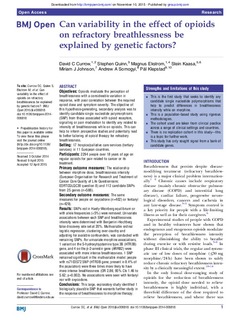| dc.contributor.author | Currow, David C. | |
| dc.contributor.author | Quinn, Stephen | |
| dc.contributor.author | Ekström, Magnus | |
| dc.contributor.author | Kaasa, Stein | |
| dc.contributor.author | Johnson, Miriam J. | |
| dc.contributor.author | Somogyi, Andrew A. | |
| dc.contributor.author | Klepstad, Pål | |
| dc.date.accessioned | 2015-11-10T11:47:32Z | |
| dc.date.accessioned | 2015-11-24T07:51:10Z | |
| dc.date.available | 2015-11-10T11:47:32Z | |
| dc.date.available | 2015-11-24T07:51:10Z | |
| dc.date.issued | 2015 | |
| dc.identifier.citation | BMJ Open 2015, 5(5) | nb_NO |
| dc.identifier.issn | 2044-6055 | |
| dc.identifier.uri | http://hdl.handle.net/11250/2365374 | |
| dc.description.abstract | Objectives: Opioids modulate the perception of breathlessness with a considerable variation in response, with poor correlation between the required opioid dose and symptom severity. The objective of this hypothesis-generating, secondary analysis was to identify candidate single nucleotide polymorphisms (SNP) from those associated with opioid receptors, signalling or pain modulation to identify any related to intensity of breathlessness while on opioids. This can help to inform prospective studies and potentially lead to better tailoring of opioid therapy for refractory breathlessness.
Setting: 17 hospice/palliative care services (tertiary services) in 11 European countries.
Participants: 2294 people over 18 years of age on regular opioids for pain related to cancer or its treatment.
Primary outcome measures: The relationship between morphine dose, breathlessness intensity (European Organisation for Research and Treatment of Cancer Core Quality of Life Questionnaire; EORTCQLQC30 question 8) and 112 candidate SNPs from 25 genes (n=588).
Secondary outcome measures: The same measures for people on oxycodone (n=402) or fentanyl (n=429).
Results: SNPs not in Hardy-Weinberg equilibrium or with allele frequencies (<5%) were removed. Univariate associations between each SNP and breathlessness intensity were determined with Benjamini-Hochberg false discovery rate set at 20%. Multivariable ordinal logistic regression, clustering over country and adjusting for available confounders, was conducted with remaining SNPs. For univariate morphine associations, 1 variant on the 5-hydroxytryptamine type 3B (HTR3B) gene, and 4 on the β-2-arrestin gene (ARRB2) were associated with more intense breathlessness. 1 SNP remained significant in the multivariable model: people with rs7103572 SNP (HTR3B gene; present in 8.4% of the population) were three times more likely to have more intense breathlessness (OR 2.86; 95% CIs 1.46 to 5.62; p=0.002). No associations were seen with fentanyl nor with oxycodone.
Conclusions: This large, exploratory study identified 1 biologically plausible SNP that warrants further study in the response of breathlessness to morphine therapy. | nb_NO |
| dc.language.iso | eng | nb_NO |
| dc.publisher | BMJ Publishing Group | nb_NO |
| dc.title | Can variability in the effect of opioids on refractory breathlessness be explained by genetic factors? | nb_NO |
| dc.type | Journal article | nb_NO |
| dc.type | Peer reviewed | en_GB |
| dc.date.updated | 2015-11-10T11:47:32Z | |
| dc.source.volume | 5 | nb_NO |
| dc.source.journal | BMJ Open | nb_NO |
| dc.source.issue | 5 | nb_NO |
| dc.identifier.doi | 10.1136/bmjopen-2014-006818 | |
| dc.identifier.cristin | 1256651 | |
| dc.description.localcode | This is an Open Access article distributed in accordance with the Creative Commons Attribution Non Commercial (CC BY-NC 4.0) license, which permits others to distribute, remix, adapt, build upon this work non-commercially, and license their derivative works on different terms, provided the original work is properly cited and the use is non-commercial. See: http://creativecommons.org/licenses/by-nc/4.0/ | nb_NO |
